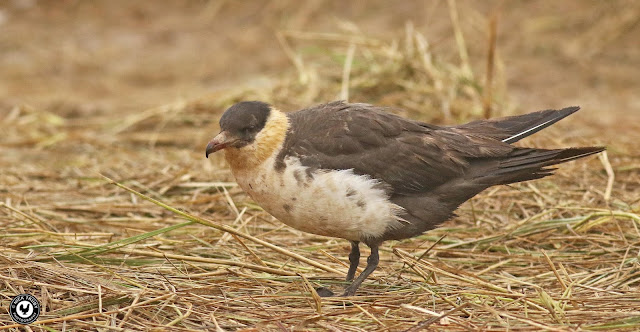Late on Wednesday evening news broke of a Black-throated Thrush that had been found within the grounds of Whipsnade Zoo in Bedfordshire. As is often the case these days a certain degree of speculation surrounded the report and when there was no repeated sighting of the bird on Thursday the knives were out and some commentators considered that the report was a hoax and that the accompanying photograph of the bird had been photoshopped! Then on Friday the bird was refound by a couple of trustworthy local birders and a major local twitch was on. I was working on that Friday so couldn't get there and besides, even I could, the traffic would be horrendous. On Saturday I was at football watching my team put in an absolutely abject performance but the Thrush had remained so it was likely that it would still be around on Sunday when Mrs Caley and myself would have the opportunity to go.
We'd seen a Black-throated Thrush before, in Maidenhead way back in January 1999, so it wouldn't be a lifer but would be an unexpected and a bonus year list addition. The fact that the bird was in the Whipsnade Zoo grounds meant that we'd have to pay to gain entry but it's always nice to have a wander round a zoo and check out some of the interesting animals even though I'm not entirely at ease with such animals being kept in confined captivity. There had been much discussion on social media about the high entry fee to get into the zoo but compared with what I paid to watch premier league football the day before it was a mere trifle! The forty odd quid it would cost to get in was also less than we'd spend on diesel getting to Norfolk or just about anywhere else in the country from Oxon so it would actually be a cheap day out!
The weather forecast was favourable with sunny intervals promised until the afternoon at least so when I pulled the curtains apart at home I was a tad disappointed to see gloomy grey skies and a spattering of rain drops hitting the patio. Our garden feeders were graced by no less than three Great Tits which is a high number for us beating the average, as it happens, by about three! It was a good morning for birds since we also had Blue Tits and Goldfinches adorning the feeders too. This glut of small birds didn't go unnoticed either since Mrs Caley suddenly shouted, "Sparrowhawk!". And there stood on the back fence was a lovely juvenile female Sparrowhawk which wore the bemused expression, I thought, of a bird that had narrowly missed out on breakfast. A nice start to the day!
 |
| Sparrowhawk |
 |
| Black-throated Thrush, Whipsnade Zoo, 15th December 2019 |
Just as the Black-throated Thrush exited stage left and flew off to some trees about a hundred metres away, the sun came out! How I, and others, could have done with that while the Thrush fed on the berries but now at least we had perfect conditions to photograph some of the Redwings that were also dining on the fruits.
 |
| Redwing |
One of the free roaming park Wallabies appeared less than impressed by mine and others efforts!
 |
| Wallaby |
While the views were unrivalled, the sun had also put in an appearance, I was struggling to get some really decent shots since the light was slightly against me so once again I left Mrs Caley enjoying fine scope views while I moved along the line of twitchers and toggers and positioned myself with the sun more at my back. Unfortunately the Thrush didn't help me by moving back into the shadows of the tree. They just don't read the script!
It wasn't long though before the Black-throated Thrush re-emerged from the shadows to feed on the berries again and I now had a chance of getting some better photos. Able now to use a lower ISO and much faster shutter speeds I was delighted, if I may say so myself, at what I captured. It's always a good feeling when good fortune shines on you as brightly as the sun. While I was shooting away I found myself thinking that I must surely have a late entry onto the Old Caley calendar for next year.
My luck was also in when the Thrush flew to another nearby tree because I was primed to keep shooting and consequently managed to get some respectable flight shots, always a bonus!
The last couple of frames of the bird perched in the bare upper branches of the tree showed just how grey the Black-throated Thrush's plumage is. But of course the black throat is extremely prominent. I do like birds that are named "like it says on the tin".
The Black-throated Thrush departed high back towards the Elephant enclosure so we did call it a day, on the twitching front at least, and went for a coffee while I tweeted out a few back of camera photos with a few happy smiling emoji's attached. We then explored the Zoo for a couple of hours heading first to the Penguins. There are two types of Penguin at Whipsnade, Rockhoppers with their wild head feathers and Black-footed which are also known as Jackass Penguins owing to their loud braying calls that sound similar to that of a Donkey. Hopefully one day I'll get to see some Penguins in the wild.
 |
| Black-footed or Jackass Penguin |
 |
| Rockhopper Penguin |
 |
| European Lynx |
 |
| Northern White Rhinoceros |
 |
| Aleksander & Sergei Meerkat |
 |
| "Pink" Pelican |
 |
| White Stork |

















































